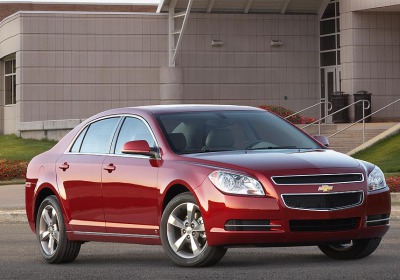GM, Chrysler sales fall more than 40 percent; Ford, Honda also slip
Thu, 01 Oct 2009The biggest automakers posted some of the sharpest U.S. sales declines in September as demand dropped to its lowest level since April in the aftermath of the cash-for-clunkers program.
The seasonally adjusted annual sales rate was 9.51 million units. After thronging dealerships during the government incentive and sending August demand to the year's high of 13.7 million, consumers backed off in September, dropping the sales rate slightly below June's 9.55 million.
“I've been in the auto business for 39 years, and I've never seen a roller coaster year like this,” said Ken Czubay, Ford Motor Co.'s vice president of U.S. marketing, sales and service.
Sales for General Motors Co. and Chrysler Group, both recovering from bankruptcy, plunged more than 40 percent, in line with analysts' forecasts. American Honda tumbled 20 percent and Toyota Motor Sales was down 13 percent. Ford Motor Co. fell 5 percent after two straight months of year-over-year gains.
Other automakers advanced. BMW Group's 4 percent rise was its first since August 2008. Porsche rose 8 percent, its second straight monthly increase. Hyundai-Kia soared 26 percent, for its third straight monthly gain.
Subaru rose 1 percent for its fourth straight increase. Subaru, up 10 percent for the year, and Hyundai-Kia, up 3 percent, preserved their year-to-date improvements.
Industry sales fell to 746,206, down 23 percent compared with September 2008 and putting the nine-month decline at 27 percent. August had marked the first year-over-year monthly gain since October 2007 and the first month this year that sales topped 1 million units.
The Lehman effect
Percentage changes are now benefitting from comparisons to an industry that was starting to collapse a year ago. September 2008 saw the fall of Lehman Brothers, an event that dragged the U.S. economy into months of further turmoil. That month's seasonally adjusted annual sales rate fell to 12.2 million units, at that time the lowest in 17 years.
"While we had some bright spots in September, it was still a challenging sales environment for the industry," said Peter Fong, head of the Chrysler brand, in a statement. "We believe the remainder of 2009 will continue to be a challenge for the U.S. automotive market. Credit markets have thawed slightly but still remain tight, and consumer confidence, as we saw in September, is tenuous."
Demand was weakest in the first half of the month, analysts said. The federal government's clunkers program, which ended Aug. 24, had stifled September sales by draining inventories and pulling ahead buyers who would have made their purchases later in the year, they said.
By the end of the month, automakers had built inventory to improve selection for shoppers, setting the stage for a gradual improvement in sales through next year.
‘Payback' time
“We expected there'd be payback in the month of September due to cash for clunkers. We are past that payback now,” said Mike DiGiovanni, GM's executive director of global market analysis.
“We won't be out of the woods for a while until the job market improves.”
Cars outsold trucks for the ninth straight month, making up 56 percent of September sales.
Ford's results included a second straight monthly gain in sales for F-series pickups. September's volume grew 4 percent from year-earlier levels. Ford released its redesigned version of the truck a year ago today.
GM's sales, on the other hand, included drops of more than 60 percent for its Chevrolet Silverado and GMC Sierra full-sized pickups.
Hyundai-Kia gained off sales of the Kia Optima sedan, which more than tripled, and the Hyundai Elantra sedan, which more than doubled.
Chrysler, GM, Honda and Nissan increased incentives from August levels, according to consumer auto site Edmunds.com. Toyota, Hyundai and Ford reduced them. Chrysler's $3,819 in incentives per vehicle led major automakers, well above the industry average of $2,557 per vehicle.
Edmunds.com includes interest rates, lease deals and rebates to dealers and consumers in its incentive measurement.
Ford, GM perspective
Ford's decline compared with a 36 percent drop a year earlier. In that month, Ford's slide was the worst among the five top-selling companies.
GM, by contrast, fell only 16 percent in September 2008, better than the industry slide of 27 percent. That reflected in part gains from a late-August and early September employee-pricing discount in honor of the company's 100th anniversary.
Chrysler benefited from a year-over-year comparison with September 2008, the first full month after its exit from leasing. Its sales fell 33 percent that month. Nissan's decline also was diminished by comparisons to last September, when its 37 percent tumble was the sharpest among the top six automakers.
Annual sales rates had remained at 27-year lows before July, drifting between 9.1 million and 9.9 million units. In July, the federal government launched cash for clunkers. The program's offer of as much as $4,500 for consumers who traded in gas guzzlers for new vehicles with better fuel efficiency pushed July sales to an annual rate of 11.1 million units.
Amy Wilson and Jamie LaReau contributed to this report.
By Chrissie Thompson- Automotive News

